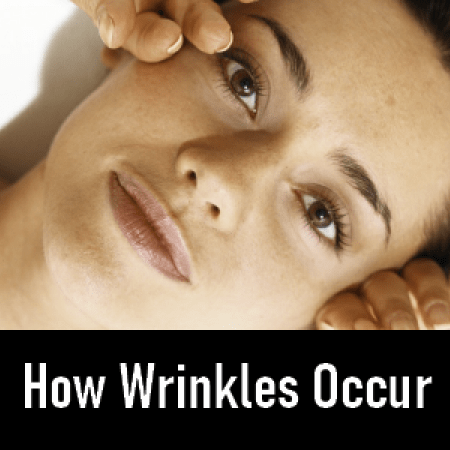طريق Panjing 399، منطقة Baoshan، شنغهاي
[email protected]
 +86-13901602592
+86-13901602592

تكوين التجاعيد هو عملية معقدة تتضمن عوامل متعددة، بما في ذلك التغيرات في بنية الجلد، والتأثيرات البيئية الخارجية، وعادات نمط الحياة.
1. الشيخوخة الداخلية (الشيخوخة الطبيعية)
انخفاض الكولاجين والألياف المرنة: مع التقدم في العمر، يتناقص إنتاج الكولاجين (حوالي 1% أقل سنويًا) والألياف المرنة في真皮، ويزداد التحلل، مما يؤدي إلى تقليل مرونة الجلد وترهلاته.
تباطؤ تجديد الخلايا: دورة التجدد للخلايا الظاهرية تطول، ويصبح الطبقة القشرية أرق، وقدرة إصلاح الجلد تضعف، وفقدان الدهون تحت الجلد يزيد من اكتئاب الجلد.
2. الشيخوخة الخارجية
الشيخوخة الضوئية (الضرر فوق البنفسجي):
تأثيرات UVA/UVB: يخترق UVA بعمق إلى البشرة ليدمر الكولاجين والألياف المرنة، مما يثير التوتر التأكسدي للجذور الحرة؛ UVB يضر بالخلايا الظاهرية ويؤثر بشكل غير مباشر على بنية البشرة.
تفعيل الميتالوبروتينازات (MMPs): زيادة التعبير عن الإنزيم الناتجة عن التعرض للأشعة فوق البنفسجية تسريع تحلل الكولاجين.
التلوث البيئي والضغط التأكسدي: الملوثات الخارجية (مثل PM2.5) والجذور الحرة تهاجم خلايا الجلد، مما يزيد من الالتهاب والتقدم في السن.
3. آليات التجاعيد الديناميكية والسكونية
التجاعيد الديناميكية: التعبيرات الوجهية المتكررة (مثل التعبير عن الغضب والابتسام) تسبب انقباض العضلات المتكرر وتشكيل خطوط مؤقتة في طيات الجلد (مثل التجاعيد حول العين). يؤدي الحركة العضلية طويلة الأمد إلى تلف بنية البشرة، مما يجعل الخطوط الديناميكية تتحول إلى خطوط ثابتة.
التجاعيد الثابتة: التجاعيد الدائمة التي لا تزال مرئية حتى عند عدم وجود تعبيرات بعد فقدان مرونة الجلد، وهي شائعة حول العينين والجبهة.
4. جفاف الجلد والتغيرات الهيكلية
جفاف الطبقة الخارجية: نقص الرطوبة في الطبقة القرنية يسبب ظهور خطوط دقيقة مؤقتة. قد يؤدي الجفاف طويل الأمد إلى تضعف الحاجز الجلدي وتسريع تلف البشرة.
انخفاض حمض الهيالورونيك: يتم فقدان العامل المرطب الطبيعي في البشرة، مما يؤدي إلى تقليل حجم الجلد وزيادة شدة ظهور التجاعيد.
5. عوامل نمط الحياة
التدخين والشرب: يُضيق النيكوتين الأوعية الدموية ويقلل من إمدادات المواد المغذية للجلد؛ الكحول يسبب الجفاف ويعتبر سبباً لفقدان الكولاجين بشكل أسرع.
النوم والغذاء: نقص النوم يعيق إصلاح الجلد ليلاً؛ أما النظام الغذائي الغني بالسكريات فيؤدي إلى تفاعلات الغليكشن، مما يتسبب في ترابط الكولاجين وتجفيفه.
6. الجاذبية وتوزيع الدهون
ترهل الجلد: بعد أن ضعفت بنية الدعم الجلدية، تساغ الأنسجة الوجهية تحت تأثير الجاذبية، مما يؤدي إلى تكوين التجاعيد حول الأنف والفم وخطوط الماريونيت وغيرها.
ضمور طبقة الدهون: انخفاض دهون تحت الجلد يؤدي إلى فقدان الدعم للجلد، مما يشكل التجاعيد المُغرقة.
7. العوامل الوراثية والاختلافات الفردية
تحدد الجينات نوع الكولاجين وسعة مضادات الأكسدة، مما يؤثر على توقيت ودرجة التجاعيد الفردية.
8. استراتيجيات التدخل والوقاية
واقي الشمس: واقي شمس واسع الطيف يقاوم الأشعة فوق البنفسجية UVA/UVB ويقلل من الشيخوخة الناتجة عن التعرض للشمس.
منتجات العناية بالبشرة: الرتينول يعزز إنتاج الكولاجين؛ مضادات الأكسدة (مثل فيتامين C) تحيد الجذور الحرة.
طرق الجمال الطبي: البوتوكس يرخي العضلات ويقلل من الخطوط الديناميكية؛ مكملات الحجم تعوض النقص في الحجم؛ الليزر يحفز تجديد الكولاجين.